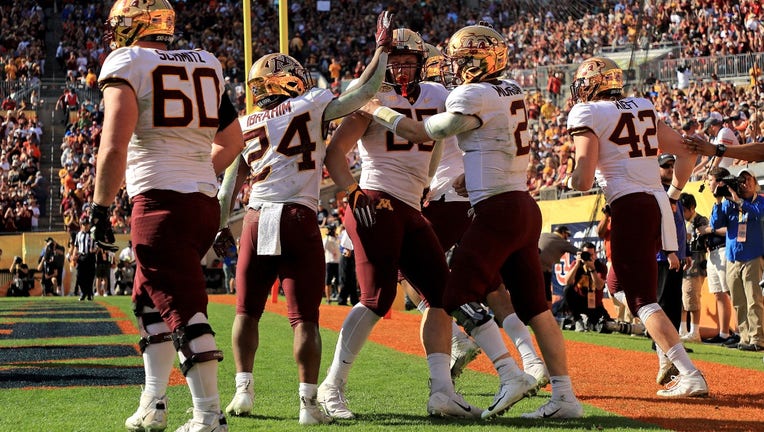A look at the Gophers offense heading into a pivotal 2020 season

Bryce Witham #85 of the Minnesota Golden Gophers celebrates a touchdown during the 2020 Outback Bowl against the Auburn Tigers at Raymond James Stadium on January 01, 2020 in Tampa, Florida. ((Photo by Mike Ehrmann/Getty Images))
MINNEAPOLIS - The University of Minnesota football team comes into the 2020 season, whenever it starts, with a chance to contend for the Big Ten West.
The Gophers are coming off an 11-2 season, their best in 115 years, which was capped with a 31-24 win over Auburn in the Outback Bowl. They were one week into spring football when the NCAA canceled all spring activities due to the Coronavirus pandemic. Now, programs are slowly having athletes trickle back to campus for voluntary workouts.
We don’t know if there will be football in the fall due to Covid-19 concerns. If there is football, we don’t know if fans will be allowed to fill TCF Bank Stadium. What we do know is if and when football returns, the Gophers should have a potent offensive attack, with nine starters back from last season.
Here's a look at the depth chart as it stands today.
Offensive Line
Maybe the best news for the Gophers offensive line is that all five starters will be back this season. The only injury concern was right tackle Daniel Faalele, who suffered a leg injury in Minnesota’s loss to Wisconsin in the regular season finale. But he was back at spring practice, and a full participant. Joining Faalele are Curtis Dunlap Jr., John Michael Schmitz, Conner Olson, Sam Schlueter and Blaise Andries. J.J. Guedet should also contribute after getting meaningful snaps last season. Behind that offensive line, the Gophers averaged 34 points per game, 178 yards rushing per game and more than four yards per carry.
Quarterbacks
The Gophers’ offense will only go as far as their quarterback takes them, and for the time being they’re in good hands with Tanner Morgan. The redshirt sophomore enters the 2020 season a potential candidate to be in the conversation for the Heisman Trophy, if he continues to trend up. Morgan completed 66 percent of his passes last year for more than 3,200 yards, 30 touchdowns and just seven interceptions. He set an NCAA record for completion percentage at Purdue, going 21-of-22. His only incompletion was a throwaway. He was one of the most efficient passers in the country last year, behind only Joe Burrow, Jalen Hurts and Justin Fields. Burrow and Hurts are now in the NFL.
If Morgan gets hurt, his back-ups are more than capable. Zach Annexstad was set to be the starter in 2019 before suffering a foot injury in fall camp that required season-ending surgery. Cole Kramer and Jacob Clark also enter their redshirt freshman seasons after playing less than four games last year.
Wide receivers
Morgan’s favorite target will likely be junior Rashod Bateman, and he’ll get plenty of attention from opposing defenses in 2020. He was named the Big Ten Receiver of the Year and First Team All-Big Ten after making 60 catches for more than 1,200 yards and 11 touchdowns. He’ll need help from Chris Autman-Bell and Demetrius Douglas. Autman-Bell stepped up last year with 28 catches for 371 yards and five touchdowns. His touchdown catch late in regulation at Fresno State last year forced overtime in a game the Gophers eventually won.
Tight ends
P.J. Fleck and co-offensive coordinators Matt Simon and Mike Sanford Jr. have the task of getting tight ends more involved in the passing game in 2020. Primarily tasked with run blocking last year, Brevyn Spann-Ford, Jake Paulson and Bryce Witham all showed receiving capabilities last year. Spann-Ford had four catches and a touchdown, Paulson had four catches and Witham had the two biggest catches of his career last season. Witham caught a touchdown on a 4th-and-goal play in the Outback Bowl against Auburn, then converted a crucial catch on fourth down in the fourth quarter to keep the clock running.
Running backs
The Gophers have holes to fill in the offensive backfield with Rodney Smith and Shannon Brooks graduated, but return one of their most effective running backs. Mohamed Ibrahim rushed for 605 yards and seven touchdowns, averaging more than five yards per carry last season. He’ll get the bulk of the carries, but Minnesota should get help from a combination of Cam Wiley, Bryce Williams, Preston Jelen and incoming freshman Ky Thomas. They’ll also continue to use Seth Green in short yardage, wildcat situations. The Gophers ran for 178.7 yards per game last season, and had 25 rushing touchdowns. Minnesota had the No. 42 total offense, the No. 46 rushing offense and the No. 21 scoring offense in the country last season.
Minnesota has every chance to be one of the more potent offenses in the country, if it gets the chance to get on the field as concerns remain over the Covid-19 pandemic.

